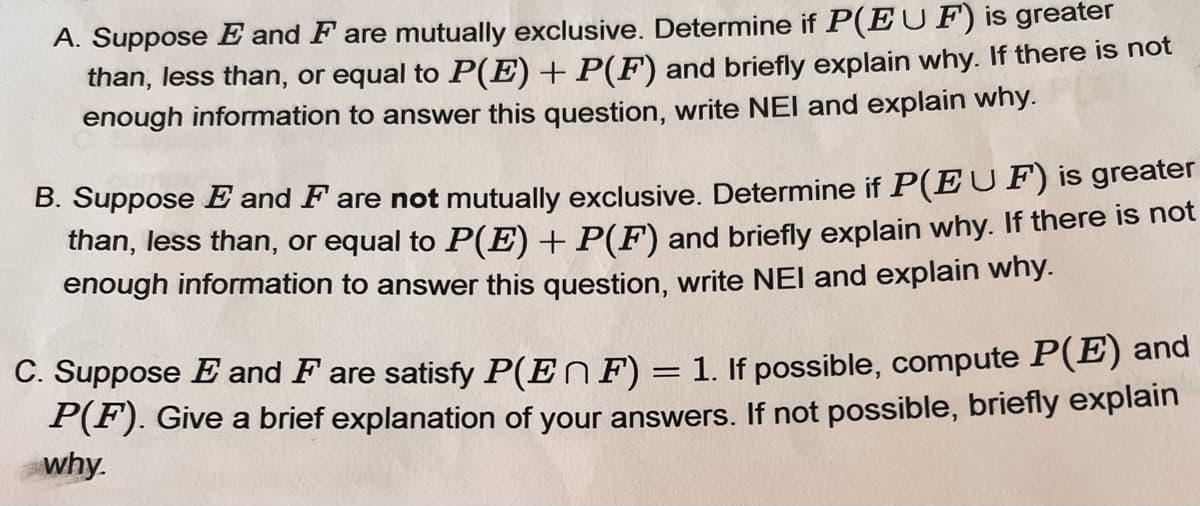A. Suppose E and F are mutually exclusive. Determine if P(EUF) is greater than, less than, or equal to P(E) + P(F) and briefly explain why. If there is not enough information to answer this question, write NEI and explain why. B. Suppose E and F are not mutually exclusive. Determine if P(EUF) is greate than, less than, or equal to P(E) + P(F) and briefly explain why. If there is no enough information to answer this question, write NEI and explain why. Suppose E and F are satisfy P(EF) = 1. If possible, compute P(E) and P(F). Give a brief explanation of your answers. If not possible, briefly explain why.
A. Suppose E and F are mutually exclusive. Determine if P(EUF) is greater than, less than, or equal to P(E) + P(F) and briefly explain why. If there is not enough information to answer this question, write NEI and explain why. B. Suppose E and F are not mutually exclusive. Determine if P(EUF) is greate than, less than, or equal to P(E) + P(F) and briefly explain why. If there is no enough information to answer this question, write NEI and explain why. Suppose E and F are satisfy P(EF) = 1. If possible, compute P(E) and P(F). Give a brief explanation of your answers. If not possible, briefly explain why.
Algebra & Trigonometry with Analytic Geometry
13th Edition
ISBN:9781133382119
Author:Swokowski
Publisher:Swokowski
Chapter1: Fundamental Concepts Of Algebra
Section1.2: Exponents And Radicals
Problem 87E
Related questions
Question
100%
Let S be a sample space with probability function P and E, F be events the following questions are independent of each other

Transcribed Image Text:A. Suppose E and F are mutually exclusive. Determine if P(EUF) is greater
than, less than, or equal to P(E) + P(F) and briefly explain why. If there is not
enough information to answer this question, write NEI and explain why.
B. Suppose E and F are not mutually exclusive. Determine if P(EUF) is greater
than, less than, or equal to P(E) + P(F) and briefly explain why. If there is not
enough information to answer this question, write NEI and explain why.
C. Suppose E and F are satisfy P(EF) = 1. If possible, compute P(E) and
P(F). Give a brief explanation of your answers. If not possible, briefly explain
why.
Expert Solution
This question has been solved!
Explore an expertly crafted, step-by-step solution for a thorough understanding of key concepts.
Step by step
Solved in 2 steps

Recommended textbooks for you

Algebra & Trigonometry with Analytic Geometry
Algebra
ISBN:
9781133382119
Author:
Swokowski
Publisher:
Cengage

Algebra: Structure And Method, Book 1
Algebra
ISBN:
9780395977224
Author:
Richard G. Brown, Mary P. Dolciani, Robert H. Sorgenfrey, William L. Cole
Publisher:
McDougal Littell

Elements Of Modern Algebra
Algebra
ISBN:
9781285463230
Author:
Gilbert, Linda, Jimmie
Publisher:
Cengage Learning,

Algebra & Trigonometry with Analytic Geometry
Algebra
ISBN:
9781133382119
Author:
Swokowski
Publisher:
Cengage

Algebra: Structure And Method, Book 1
Algebra
ISBN:
9780395977224
Author:
Richard G. Brown, Mary P. Dolciani, Robert H. Sorgenfrey, William L. Cole
Publisher:
McDougal Littell

Elements Of Modern Algebra
Algebra
ISBN:
9781285463230
Author:
Gilbert, Linda, Jimmie
Publisher:
Cengage Learning,

Glencoe Algebra 1, Student Edition, 9780079039897…
Algebra
ISBN:
9780079039897
Author:
Carter
Publisher:
McGraw Hill

Elementary Linear Algebra (MindTap Course List)
Algebra
ISBN:
9781305658004
Author:
Ron Larson
Publisher:
Cengage Learning